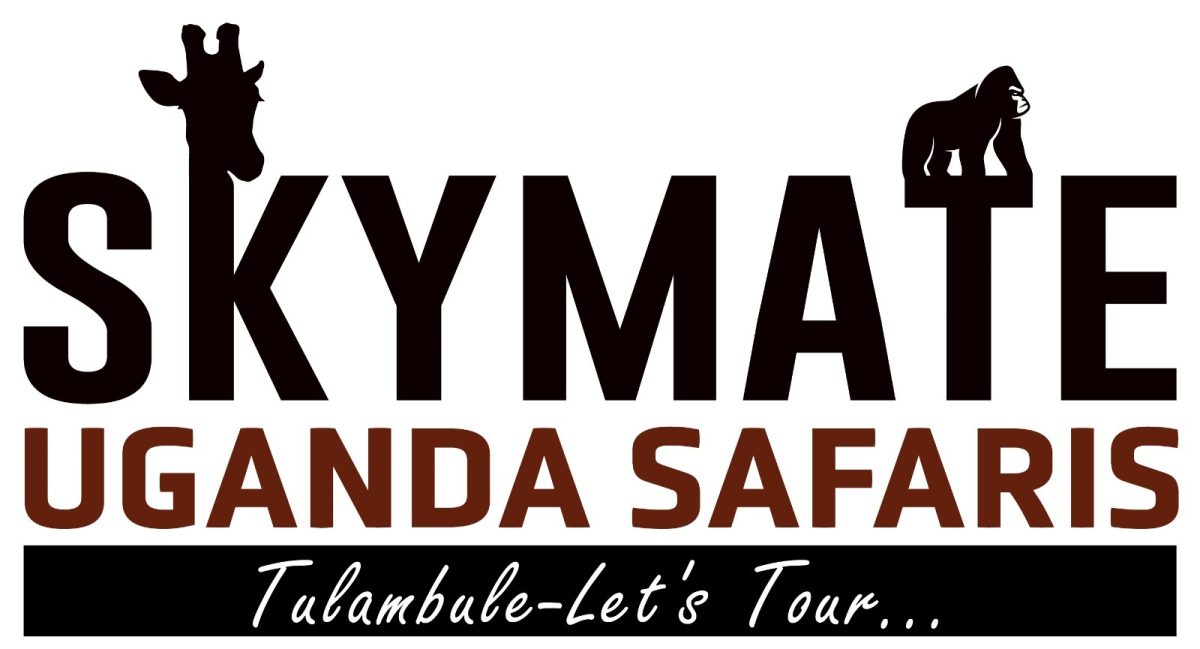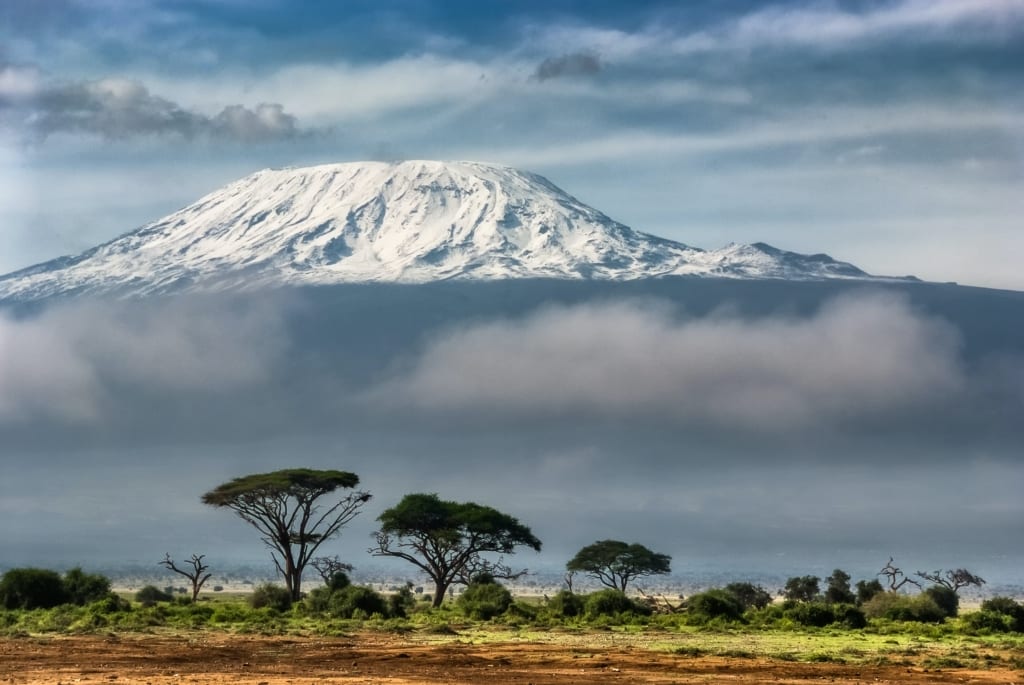Table of Contents
ToggleIs Climbing Kilimanjaro Hard?
Is Climbing Kilimanjaro Hard? Tanzania‘s Mount Kilimanjaro is not a very difficult mountain to climb. Almost anyone can climb Kilimanjaro.
But as you plan your Kilimanjaro climbing adventure, please note that is an extreme altitude mountain trek. And more than 50% of the climbers suffer from altitude sickness.
Measuring 19,341 feet, or 5,895 meters, you will need to prepare well, be determined and train before attempting to climb Kili.

How hard is climbing Kilimanjaro?
There is no a straight answer to this question. It actually depends on a lot of factors such as your fitness level, age, the number of days of the trek, the route to climb, and more.
However, do not allow these factors to intimidate you, either!
Anne Lorimor, a great-grandmother climbed Mount Kilimanjaro at age 85. However, the record of oldest person to summit Kilimanjaro was taken from her by Angela Vorobeva a few years later. Thus, to win her title back she successfully climbed Mount Kilimanjaro again in 2019 at the age of 89 and 37 days!
And consider the 6-year-old Coalton Tanner who successfully reach Uhuru Peak, the true summit, in October 2018, and holds the record for the youngest climber to peak of Africa’s tallest mountain.
What you need, is to consider all the key factors and determine how to appropriately manage them. You can regularly train to physically prepare. You also need to book your trek during the dry season for the best chance at sunny weather. Buy or rent quality gear and hike with a trained/qualified guide.
Mount Kilimanjaro National Park is an awesome feat, and should not be taken lightly — you earn major bragging rights when you reach the roof of Africa.
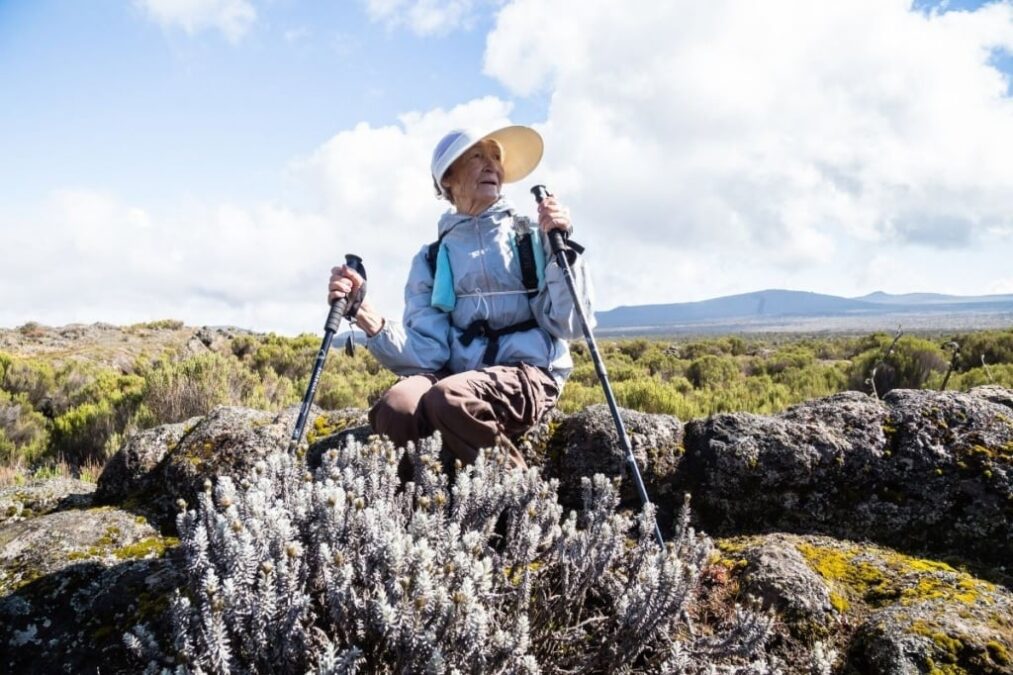
Is Kilimanjaro a hike? A climb? Or a trek?
A hike is the least complicated and simplest activity: basically, it is walking.
A hike does not require you to be with any special equipment or knowledge. Just add a water bottle, a pack with a few snacks and call yourself a hiker! And many people walk in basic running shoes or trainers. Of course, there are more strenuous hikes, steep inclines and multi-day adventures.
Trekking suggests more difficult landscape or terrain in a somewhat remote place, for a longer time. You should have suitable shoes and some knowledge of equipment, such as a trekking poles.
Technically, Kilimanjaro is a trek. It takes several days or a week to summit Mount Kilimanjaro and adventurers cover various terrains and should be led by an expert guide to reach the top.
Whereas many trekkers complete the trek unaided, others use trekking poles or are aided with oxygen to reach the summit. Hence, reaching the highest point in Africa is termed a trek.
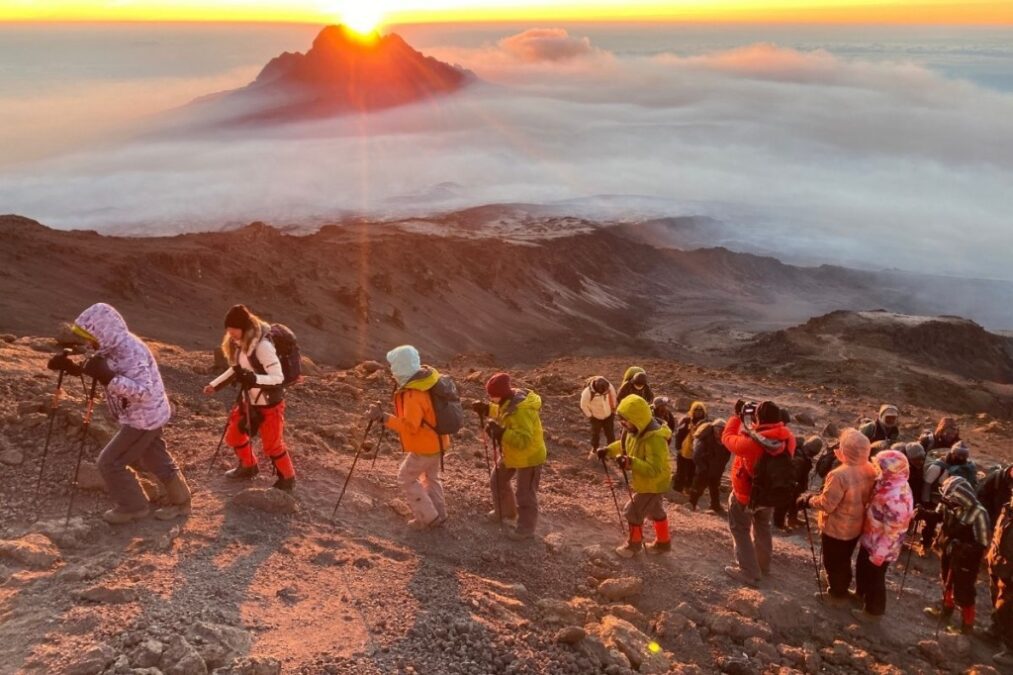
Climbing or mountain climbing is the most challenging category and sometimes requires specialized equipment or skills. Mountain climbing also has an important focus on acclimatization for high altitudes.
Although Mount Kilimanjaro is not as tall as Mount Everest, it is still very important to consider proper altitude acclimatization in order to reach the highest point.
Mount Kilimanjaro is the highest free-standing mountain on Earth. And it is one of the “Seven Summits” or the highest peaks on each of the seven continents.
Mount Kilimanjaro is also the only one of the Seven Summits that does not require specialized equipment to reach the top. Kilimanjaro is a mountain, therefore you are right to call it a mountain climb.
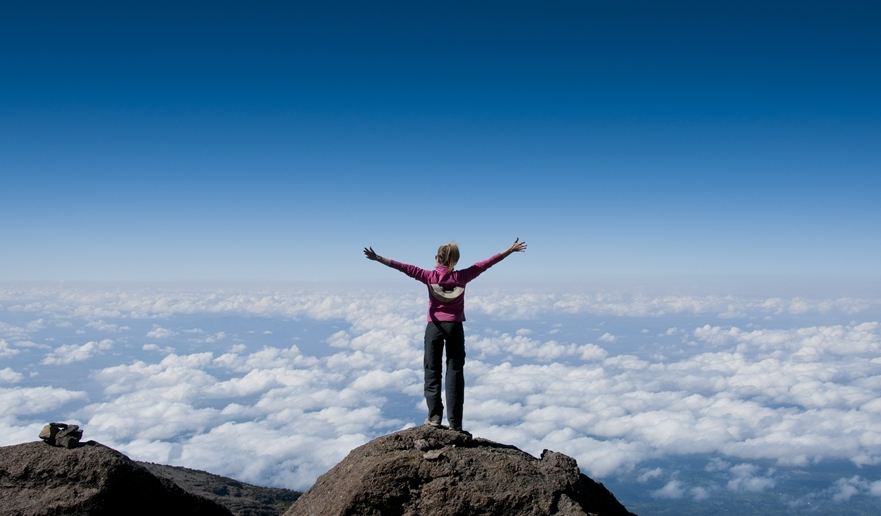
The first days of your Mount Kilimanjaro trek will begin as hikes and can be completed in regular sports training shoes. The next days will present more hard terrain and higher altitudes, turning into a trek.
So, it is appropriate to use all three terms (hike, trek, climb) interchangeably for Kilimanjaro, but if you want to be precise; Kilimanjaro is a trek.
In brief, daily hikes contribute to the general trek of climbing Mount Kilimanjaro. All of these terms are appropriate to use for Kilimanjaro climbing.
Can a beginner climb Kilimanjaro? - Can an average person climb Kilimanjaro?
Yes! Mount Kilimanjaro is not a technical climb. It is perfectly suitable for beginners with little or no experience. However you do need to be fit, determined, and ready for what’s involved. If you have some doubts? You can read about these inspirational climbers:
- Montannah Kenney is the record holder for the world’s youngest female climber, who completed the Kilimanjaro trek in 2017 at the age of 7.
- Corrine Hutton, a quadruple amputee successfully climbed Kilimanjaro while wearing prosthetic limbs in 2018.
- Anne Lorimor, an American, holds the title of oldest female, in fact the oldest person climber to summit Kilimanjaro. She was aged 89 years and 37 days and reached Uhuru Peak at 3:14 p.m. local time on 18 July 2019.
- Fred Dishelhorst, from the USA still holds the record for oldest man to climb Kilimanjaro, earned in 2017 at the age of 88 years old.
- Colin M. Barker of USA reached Uhuru Peak, the true summit, unassisted, at the age of ten years, on December 22, 2020, taking the difficult Machame Route.
- Kyle Manard, who was born without arms or legs, climbed Kilimanjaro in 2012 without the aid of prosthetics.
- Karl Egloff, the Swiss-Ecuadorian mountain guide holds the record of the fastest ascent and the fastest round trip. On 13 August 2014, after guiding a party to the summit the previous days, he ran from Umbwe Gate to the top in 4 hours and 56 minutes and returned to the Mweka Gate at 1,630 m (5,350 ft.) in a total time of 6 hours, 42 minutes and 24 seconds.
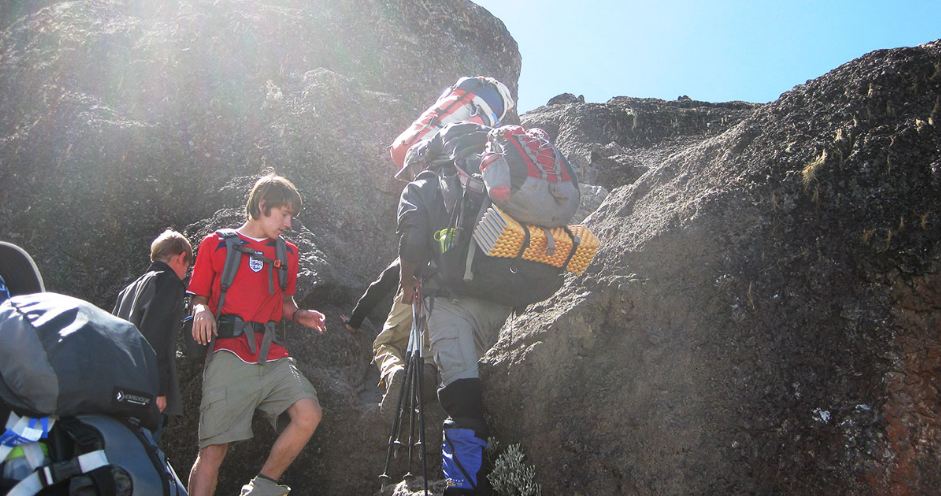
Who should not climb Kilimanjaro? - Specific health conditions that are not recommended to attempt Kilimanjaro
- People with severe forms of cardiovascular disease
- Children below 8 years. The actual required age by Tanzania law is 10 years old; children who have fought for the World Record have needed special permission from the government and presented evidence of their extraordinary climbing ability.
All other climbers are welcome to sign up!
Diabetes, asthma, or other disorders are not an impediment to this trip. Please consult with your doctor before beginning training and discuss your plans to trek Kilimanjaro.
How to prepare for a Kilimanjaro trek?
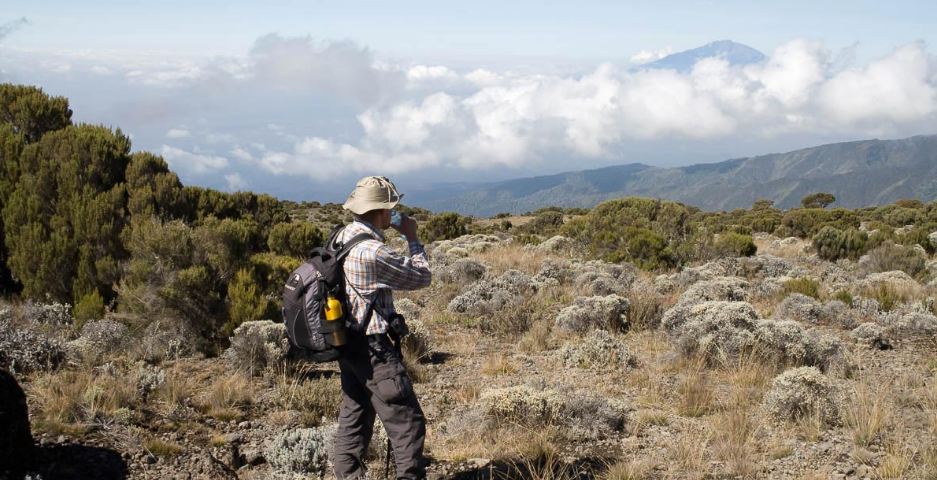
There are many steps you can take to address challenges for climbing Kilimanjaro.
Weather cannot be controlled; instead, ensure to pack quality gear that is waterproof and book your climb during the dry season, January through March or August through September.
Train regularly, following our training schedule to be physically fit for the climb, but also plan to climb a route that suits your fitness level. The Machame (7-day), Lemosho (7 and 8-day) and Northern Circuit routes are considered easier and recommended for beginner climbers.
The Umbwe route, and shorter itineraries of Marangu and Machame (5 and 6 day respectively) while incredibly scenic, is one of the most difficult routes for summiting Kilimanjaro and should be considered only if you feel physically up for the challenge
You also need to consider the number of days for a trek and the time of year. It is harder to climb Kilimanjaro in five days than it is to climb it in seven days (read more about acclimatization).
If you live at a low elevation, consider giving yourself more time to acclimatize to the altitude, or prepare with altitude simulation devices, which we discuss more in this article. The quality of equipment and proficiency of your group’s guide are crucial factors in a Kilimanjaro climb. For your own safety, ensure you are investing in quality equipment and joining a team with a good reputation; do not skimp in this area.
How long does it take to climb Mount Kilimanjaro?

For the so-called sky-runners it is a matter of several hours to get to the summit of Kilimanjaro and back. Karl Egloff ran up Kilimanjaro in 6 hours and 42 minutes and is the world record holder for speed.
Not only is Karl a professional athlete, but he also spent time acclimatizing to the high altitude before starting his speedy ascent.
The average person should consider trekking tours with 7 and longer days to acclimate better. 5 and 6-day climbing packages should be normally avoided (unless you have a very good fitness level), with the exception of Marangu and Lemosho 6-day programs for the time-constrained climbers.
Please note that the more days you spent on Mount Kilimanjaro the more likely you will successfully reach the summit, as you will become more acclimatized to the altitude and will be less fatigued.
What is the average Kilimanjaro success rate?
Also there is no direct answer for this question. Although some companies that offers Kilimanjaro treks publish their own success rates – which can be based on a member of a group successfully summiting, not necessarily all members. The official statistics from the Tanzania Government are much outdated.
There are no official, reliable statistics on the average success rate available at this time. The last official statistics were published in 2006 by the Kilimanjaro National Park. It says exactly the following:
- All climbers, all routes ———- 45%
- All climbers, all 5-day routes – 27%
- All climbers, all 6-day routes – 44%
- All climbers, all 7-day routes – 64%
- All climbers, all 8-day routes – 85%
Please note that the standards for trekking Kilimanjaro back in 2006 are also not on par with the current requirements. This is good news for prospective climbers! Companies now use much better equipment and employ qualified guides.
Thus, presumably, the success rate for climbing Kilimanjaro should be higher than the outdated statistics. The main principle still remains that more days on Mount Kilimanjaro allows for better acclimatization to the high altitude and increases the chances of a successful summit.
Kilimanjaro routes - Difficulty Levels
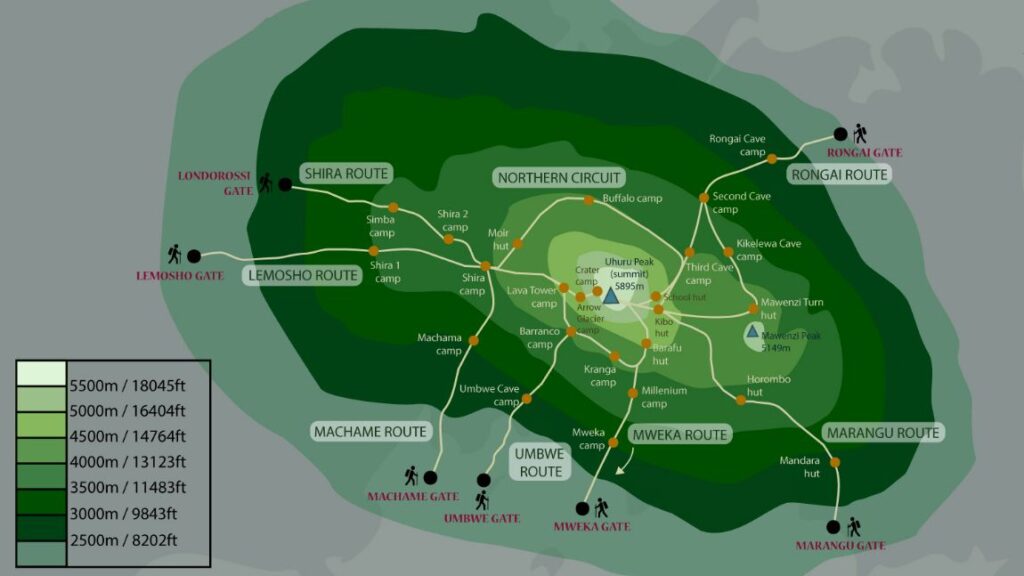
1. Lemosho Route
Lemosho Route is incredibly scenic. It is also considered one of the easier routes. The terrain on this route to Barranco Camp is rather flat, making the first day easy. This route also has been used by many record-holders for age, including the youngest and oldest record holders. This route is typically attempted over 7 to 8 days.
2. Machame Route
Machame Route trek is one of the most scenic approaches up Kilimanjaro. It is highly sought after because of the beautiful trek through a rainforest on the first day. However, its 6-day itinerary is one of the most difficult ones. And we recommend a much simpler 7-day itinerary to help reach Uhuru Peak.
3. Marangu Route
Marangu is a tough route. It has one of the lowest success rates, especially for climbers on the 5-day itinerary. A 6-day hike is much better generally, even better than a 6-day Machame Route.
A draw-back is that this climbing route can be quite crowded during high season. Also, the same route is used both for ascent and descent.
4. Rongai Route
Rongai Route is the only route that approaches Mount Kilimanjaro from the north, near the Kenyan border. The 7-day Kilimanjaro trek poses some challenges but is overall a great climb for acclimatization. It is not advised to attempt this route in less than 7 days.
5. Northern Circuit Route
Northern Circuit Route poses an incredible adventure. It includes crater camping and hiking along a less traveled route. While offering the longest itinerary (8 or 9 days), the scenery around the circuit is incredible and well worth the added days. And the longer route provides for excellent acclimatization.
6. Umbwe Route
Umbwe Route is a very steep ascent. It is only suggested for the most experienced climbers. Karl Egloff and other ‘sky runners’ summited Mount Kilimanjaro via this route.
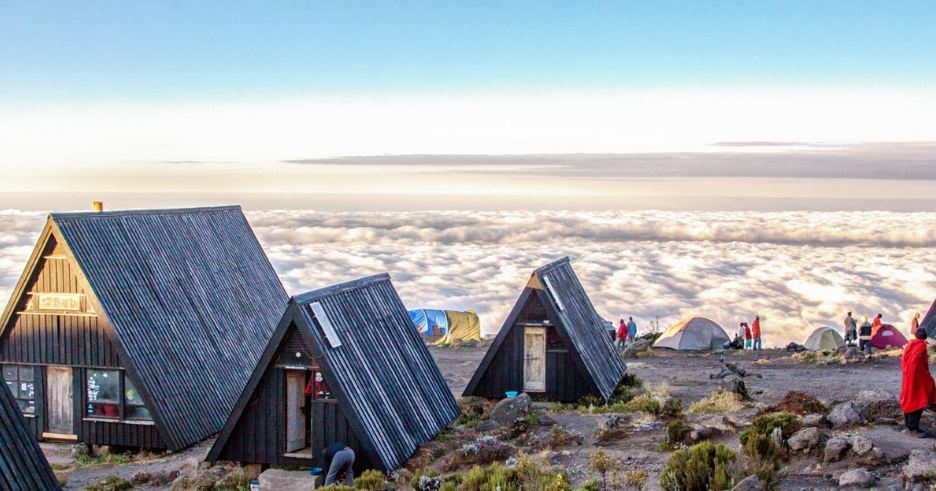
What is the hardest part of climbing Kilimanjaro?
By far one of the hardest part of climbing mount Kilimanjaro is the night-time summit attempt.
How difficult is it to climb Kilimanjaro on the last stage of the trek?
The final day of Kilimanjaro trek is the most challenging. However, some climbers who trained and prepared in advance find it surprisingly easier than expected. Keep in mind some highlights of the summit night:
- A midnight start. Your team will be walking in the dark.
- The uphill trek is steep, but completely walkable.
- You will walk 5-7 hours to meet the wonderful sunrise at Uhuru Peak.
- You will be offered snacks along the way (tea, biscuits) to help boost your energy and stamina.
Your guide will be with you and your team the entire way, encouraging you and giving support as needed. Of those who are able to reach the summit camp, on a 7-day itinerary, 90% of climbers reach the Uhuru Peak.
Others usually reach Stella Point, which is only a 40-minute trek from Uhuru Peak, the highest point of Kilimanjaro.
How easy is it to Climb Kilimanjaro Compared to Other Seven Highest Summits?
The Seven Summits (the highest peaks on each of the seven continents) is an amazing bucket-list challenge. Many choose to climb Kilimanjaro because it is considered one of the easiest to summit. Only Mount Kosciuszko (2,228 meet/7,310 feet) in Australia, which has a lower altitude, is easier.
Mount Kilimanjaro is a great climb to test acclimatization before attempting more tough peaks such as Monte Blanc, Aconcagua and Elbrus. It also offers climbers confirmation if they want to try for all seven summits and invest their time and energy (and money in climbing equipment!) in this challenge.

How long should you train for Kilimanjaro Trek?
You must train as much as you can to prepare for your Kilimanjaro mountain climbing adventure. Ideally, begin 4 months before your trekking trip.
However, there are so many adventurous travelers that book a Mount Kilimanjaro Climbing tours and have no preparation training at all!
These successful climbers summit Mount Kilimanjaro due to great guides and quality gear.
How do you acclimatize for Kilimanjaro? (Altitude Acclimatization)
The saturation of oxygen in the air is directly impacted by altitude.
Though the air we breathe at sea level is not pure oxygen, it is usually a combination of nitrogen, oxygen, a bit of carbon dioxide and traces of other gases. This air has enough saturation of oxygen to suit our needs, and our body has adapted to this.
At higher altitude, the air is ‘thinner’/is less saturated with oxygen. The effects of lower oxygen can be fatigue or feeling out of breath. It requires more breaths to obtain the same amount of oxygen, especially noticeable during physical exercise.
Your hiking over the consecutive days will be passing the “High Altitude” marker, 8,000 feet, where most individuals begin to be affected by altitude sickness.
The summit of Mount Kilimanjaro is within the “Extreme” category of elevation, however much of the trek will be within the “Very High” category.
At this altitude, the body wills starts to adapt to a higher altitude, first with an increased heart rate and respiratory rate, and later – perhaps a few days later – an increase in red blood cells. More red cells mean more oxygen delivered throughout the body, and is a sign of acclimatization.
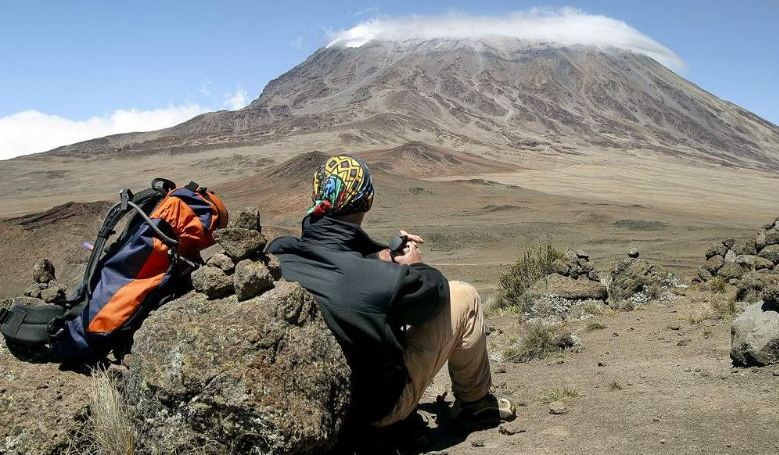
Kilimanjaro altitude sickness
Altitude sickness is a real danger on Kilimanjaro mountain climbing adventure. And all Kilimanjaro qualified guide are trained and prepared to handle.
Guides are equipped with Diamox (a brand name for the medication Acetazolamide) which helps to combat the symptoms many experience at high altitudes.
This is to ensure your comfort, but it is not a quick fix to acclimatization. It is merely helping your body with symptoms such as dizziness, nausea and headaches, you still need to advance up the highest point in Africa at a steady, safe pace.
The reason for the higher success rate for longer climbs on Kilimanjaro is due to allowance for trekkers to properly acclimatize. Making acclimatization a priority, and booking a trek of 6 or more days, is one of the most important factors for a successful summit.
How do I prepare for Kilimanjaro altitude Sickness?
The major cause of Mountain Kilimanjaro altitude sickness is climbing to a high altitude too rapidly.
Some of the symptoms of altitude sickness include: nausea, severe headaches, lack of appetite, dizziness and difficulty sleeping. It is vital to share with your guide any symptoms you’re having, especially if you’ve trouble sleeping or your appetite is reduced. The focus on acclimatization is two-fold: helps climbers successfully summit and also helps prevent altitude sickness.
The same principles for proper acclimatization are followed to combat altitude sickness:
- Choosing longer routes
- Walking slowly
- Listening to the guide
- Drinking plenty of water
- Taking Diamox pills to minimize the symptoms of high-altitude transition

How do you know if you have altitude sickness? (Signs and Symptoms)
Normal
Some of the symptoms associated with altitude are normal, including:
- Increased breathing
- Shortness of breath
- Irregular breathing patterns while sleeping
- Awake often during the night
- Increased urination
Caution
If a headache is present in combination with any of the following symptoms:
- Dehydration
- Fatigue or weakness
- Dizziness or lightheadedness
- Difficulty sleeping
Caution
If any of these symptoms are present, descend immediately to a lower elevation to acclimatize further before re-ascending. Pushing past these symptoms can result in death.
- Confused thought
- Loss of coordination (ataxia)
- Difficulty understanding or speaking
- Vision disturbances
- Extreme fatigue
- Breathlessness at rest
- Shallow breathing
- Cough
- Pink frothy sputum
- Gurgling
- Chest tightness
- Blue lips / fingernail beds

Acute Mountain Sickness (AMS)
While almost every Kilimanjaro climber experiences some form of Acute Mountains Sickness, the ‘climb high, and sleep low’ approach typically treats the symptoms.
However, it is not advisable to continue climbing with the symptoms of Acute Mountain Sickness. Left untreated, AMS can develop into HAPE or HACE; serious conditions that could be life-threatening.
HAPE means High Altitude Pulmonary Edema. It is a build-up of fluid in the lungs due to the pressure and stress of the high altitude on one’s respiratory system.
HACE means High Altitude Cerebral Edema. This results from increased pressure on the cerebral membrane and leads to swelling of the brain.
While both of these conditions need medical treatment, the majority of patients quickly improve upon descent with no further complications. And both conditions are directly related to the body’s response to high altitude.
Kilimanjaro Mountain Rescue
Most reputable Kilimanjaro trekking operates care about your safety and they put every precaution to ensuring you are in good hands; from trained guides, top gear and slow acclimatization to prevent any emergency.
You’re required to be insured in case of a serious emergency. With insurance, you and your team are covered from the unexpected, including a helicopter rescue, if necessary.
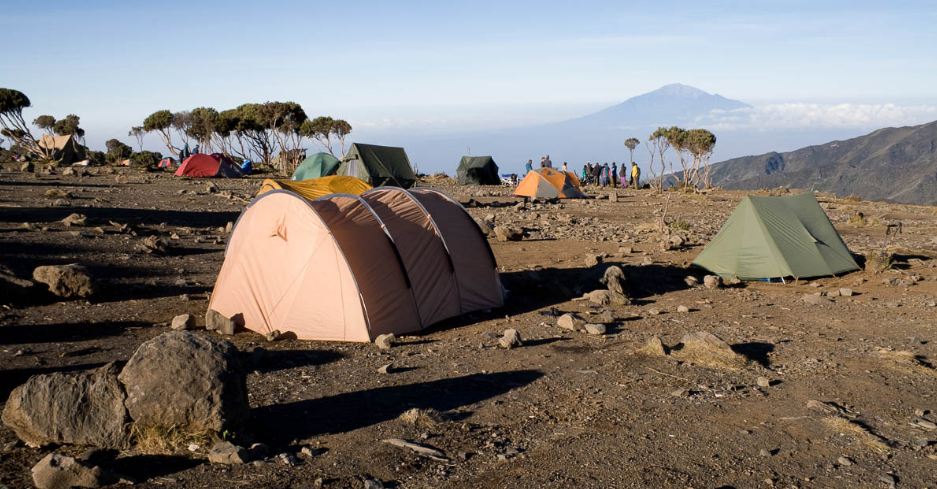
Can you climb Kilimanjaro without a guide?
It is impossible to climb Kilimanjaro without a guide! Kilimanjaro National Park Regulations do not allow treks without a licensed guide.
This is for your safety. In technical terms, you can climb Mount Kilimanjaro with a guide only – no porters, no camp team, and no cooks. But that would be very difficult and stressful for you. Also, it would be a much longer trek if you carry all the necessary equipment yourself!
What is the Minimum Age to Climb Kilimanjaro?
The minimum age for reaching the summit is 10 years under the Kilimanjaro National Park rules. However children below 15 years can find the long trek boring and the last days may be dangerous for them.
Contact us if you feel your child under the age of 15 is up to the challenge of Kilimanjaro so that we can prepare for your child’s individual needs.
What is the best age to climb Kilimanjaro?
The official minimum age to climb Kilimanjaro is set by the Kilimanjaro National Park authorities. However, the risks of trekking at altitude mean it is advised against rushing into this trek with a child. For this reason, most Kilimanjaro tour operators offer this trek to children aged 15 and above.
Conclusion – Is Climbing Kilimanjaro Really Hard?
Climbing Kilimanjaro presents many challenges, but all of them are manageable. Summiting Africa’s tallest mountain requires planning, setting aside enough time to appropriately acclimatize to the altitude and physical training. Whilst Kili is difficult, it is not out of reach. Whether you aim to climb all of the Seven Summits or are chasing the best ‘selfie’ at Uhuru Peak, start planning today!
